The Matter from Which an Orange Colour Is Made: On the Arsenic Pigment Used in a Portuguese Mannerist Painting
Abstract
1. Introduction
2. Methods
3. Results
3.1. Colour and Morphology
3.2. Elemental Composition
3.3. Structural Data
4. Discussion
4.1. Material Significance
4.2. Historical Significance
5. Conclusions
Author Contributions
Funding
Data Availability Statement
Acknowledgments
Conflicts of Interest
References
- Serrão, V. Pedro Nunes (1586–1637)—Um notável pintor maneirista eborense. A Cid. Évora 1988–1993, 45–50, 105–137. [Google Scholar]
- FitzHugh, E.W. (Ed.) Orpiment and realgar. In Artists’ Pigments. A Handbook of Their History and Characteristics; National Gallery of Art: Washington, DC, USA, 1997; Volume 3, pp. 47–79. [Google Scholar]
- Cruz, A.J. A cor e a substância: Sobre alguns pigmentos mencionados em antigos tratados portugueses de pintura—Pigmentos amarelos. Artis Rev. Inst. História Arte Fac. Let. Lisb. 2007, 6, 139–160. [Google Scholar]
- Hall, M.B. Color and Meaning. Practice and Theory in Renaissance Painting; Cambridge University Press: Cambridge, UK, 1992. [Google Scholar]
- Eastaugh, N.; Walsh, V. The Pigment Compendium. Optical Microscopy of Historic Pigments; Elsevier Butterworth-Heinemann: Oxford, UK, 2004. [Google Scholar]
- Grundmann, G.; Richter, M. Types of dry-process artificial arsenic sulphide pigments in cultural heritage. In Fatto d′Archimia. Los Pigmentos Artificiales en las Técnicas Pictóricas; Egido, M.D., Kroustallis, S., Eds.; Ministerio de Educación, Cultura y Deporte: Madrid, Spain, 2012; pp. 119–144. [Google Scholar]
- Douglass, D.L.; Shing, C.; Wang, G. The light-induced alteration of realgar to pararealgar. Am. Mineral. 1992, 77, 1266–1274. [Google Scholar]
- Vermeulen, M.; Saverwyns, S.; Coudray, A.; Janssens, K.; Sanyova, J. Identification by Raman spectroscopy of pararealgar as a starting material in the synthesis of amorphous arsenic sulfide pigments. Dye. Pigment. 2018, 149, 290–297. [Google Scholar] [CrossRef]
- Golovchak, R.; Shpotyuk, O.; McCloy, J.S.; Riley, B.J.; Windisch, C.F.; Sundaram, S.K.; Kovalskiy, A.; Jain, H. Structural model of homogeneous As–S glasses derived from Raman spectroscopy and high-resolution XPS. Philos. Mag. 2010, 90, 4489–4501. [Google Scholar] [CrossRef]
- Bonazzi, P.; Bindi, L. A crystallographic review of arsenic sulfides: Effects of chemical variations and changes induced by exposure to light. Z. Für Krist. 2008, 223, 132–147. [Google Scholar] [CrossRef]
- Vermeulen, M.; Palka, K.; Vlček, M.; Sanyova, J. Study of dry- and wet-process amorphous arsenic sulfides: Synthesis, Raman reference spectra, and identification in historical art materials. J. Raman Spectrosc. 2019, 50, 396–406. [Google Scholar] [CrossRef]
- Georgiev, D.G.; Boolchand, P.; Jackson, K.A. Intrinsic nanoscale phase separation of bulk As2S3 glass. Philos. Mag. 2003, 83, 2941–2953. [Google Scholar] [CrossRef]
- Trentelman, K.; Stodulski, L.; Pavlosky, M. Characterization of Pararealgar and Other Light-Induced Transformation Products from Realgar by Raman Microspectroscopy. Anal. Chem. 1996, 68, 1755–1761. [Google Scholar] [CrossRef]
- Agricola, G. De Natura Fossilium (Textbook of Mineralogy); Dover Publications: New York, NY, USA, 2004. [Google Scholar]
- Geoffroy, E.-F. A Treatise of the Fossil, Vegetable, and Animal Substances, That Are Made Use of in Physick; W. Innys and R. Manby: London, UK, 1736. [Google Scholar]
- Biringuccio, V. The Pirotechnia; Smith, C.S., Gnudi, M.T., Eds.; Dover Publications: New York, NY, USA, 1990. [Google Scholar]
- Sarmento, J.D.C. Materia Medica; London, UK, 1735. [Google Scholar]
- Charas, M. Pharmacopée Royale Galénique et Chymique; Chez Anisson & Posuel: Paris, France, 1676. [Google Scholar]
- Veliz, Z. (Ed.) Artists′ Techniques in Golden Age Spain. Six Treatises in Translation; Cambridge University Press: Cambridge, UK, 1986. [Google Scholar]
- Ferreira, S.T. Segredos Necessarios para os Officios, Artes, e Manufacturas; Office de Simão Thaddeo Ferreira: Lisboa, Portugal, 1794; Volume 2. [Google Scholar]
- Merrifield, M.P. (Ed.) Medieval and Renaissance Treatises on the Arts of Painting; Dover Publications: New York, NY, USA, 1999. [Google Scholar]
- Richter, M.; Grundmann, G.; Loon, A.V.; Keune, K.; Boersma, A.; Rapp, K. The occurrence of artificial orpiment (dry process) in northern European painting and polychromy and evidence in historical sources. In Auripigment/Orpiment. Studien zu Dem Mineral Und Den Künstlichen Produkten/Studies on the Mineral and the Artificial Products; Schuller, M., Emmerling, E., Nerdinger, W., Eds.; Verlag Anton Siegl: München, Germany, 2007; pp. 169–188. [Google Scholar]
- Leão, D.N.D. Descripção do Reino de Portugal; Iorge Rodriguez: Lisboa, Portugal, 1610. [Google Scholar]
- Jovanovski, G.; Makreski, P. Intriguing minerals: Photoinduced solid-state transition of realgar to pararealgar—Direct atomic scale observation and visualization. Chem. Texts 2020, 6, 5. [Google Scholar] [CrossRef]
- Gliozzo, E.; Burgio, L. Pigments—Arsenic-based yellows and reds. Archaeol. Anthropol. Sci. 2022, 14, 4. [Google Scholar] [CrossRef]
- Emelina, A.L.; Alikhanian, A.S.; Steblevskii, A.V.; Kolosov, E.N. Phase diagram of the As-S system. Inorg. Mater. 2007, 43, 95–104. [Google Scholar] [CrossRef]
- Simoen, J.; De Meyer, S.; Vanmeert, F.; de Keyser, N.; Avranovich, E.; Van der Snickt, G.; Van Loon, A.; Keune, K.; Janssens, K. Combined Micro- and Macro scale X-ray powder diffraction mapping of degraded Orpiment paint in a 17th century still life painting by Martinus Nellius. Herit. Sci. 2019, 7, 83. [Google Scholar] [CrossRef]
- Vermeulen, M.; Janssens, K.; Sanyova, J.; Rahemi, V.; McGlinchey, C.; De Wael, K. Assessing the stability of arsenic sulfide pigments and influence of the binding media on their degradation by means of spectroscopic and electrochemical techniques. Microchem. J. 2018, 138, 82–91. [Google Scholar] [CrossRef]
- Keune, K.; Mass, J.; Meirer, F.; Pottasch, C.; van Loon, A.; Hull, A.; Church, J.; Pouyet, E.; Cotte, M.; Mehta, A. Tracking the transformation and transport of arsenic sulfide pigments in paints: Synchrotron-based X-ray micro-analyses. J. Anal. At. Spectrom. 2015, 30, 813–827. [Google Scholar] [CrossRef]
- Grundmann, G.; Richter, M. Current Research on Artificial Arsenic Sulphide Pigments in Artworks: A Short Review. Chimia 2008, 62, 903–907. [Google Scholar] [CrossRef]
- Grundmann, G.; Ivleva, N.; Richter, M.; Stege, H.; Haisch, C. The rediscovery of sublimed arsenic sulphide pigments in painting and polychromy: Applications of Raman microspectroscopy. In Studying Old Master Paintings. Technology and Practice; Spring, M., Ed.; Archetype Publications: London, UK, 2011; pp. 269–276. [Google Scholar]
- Grundmann, G.; Rötter, C. Artificial orpiment: Microscopic, diffractometric and chemical characteristics of synthesis products in comparison to natural orpiment. In Auripigment/Orpiment. Studien zu Dem Mineral Und Den Künstlichen Produkten/Studies on the Mineral and the Artificial Products; Schuller, M., Emmerling, E., Nerdinger, W., Eds.; Verlag Anton Siegl: München, Germany, 2007; pp. 105–136. [Google Scholar]
- Penny, N.; Spring, M. Veronese’s paintings in the National Gallery. Techniques and materials: Part II. Natl. Gallery Tech. Bull. 1996, 17, 32–55. [Google Scholar]
- Dunkerton, J.; Spring, M. Titian’s Painting Technique to c.1540. Natl. Gallery Tech. Bull. 2013, 34, 4–31. [Google Scholar]
- Wallert, A. (Ed.) Still Life: Techniques and Style. An Examination of Paintings from the Rijksmuseum; Rijksmuseum: Amsterdam, The Netherlands, 1999. [Google Scholar]
- Keune, K.; Mass, J.; Mehta, A.; Church, J.; Meirer, F. Analytical imaging studies of the migration of degraded orpiment, realgar, and emerald green pigments in historic paintings and related conservation issues. Herit. Sci. 2016, 4, 10. [Google Scholar] [CrossRef]
- van Loon, A.; Noble, P.; Krekeler, A.; Van der Snickt, G.; Janssens, K.; Abe, Y.; Nakai, I.; Dik, J. Artificial orpiment, a new pigment in Rembrandt’s palette. Herit. Sci. 2017, 5, 26. [Google Scholar] [CrossRef]
- De Keyser, N.; Van der Snickt, G.; Van Loon, A.; Legrand, S.; Wallert, A.; Janssens, K. Jan Davidsz. de Heem (1606–1684): A technical examination of fruit and flower still lifes combining MA-XRF scanning, cross-section analysis and technical historical sources. Herit. Sci. 2017, 5, 38. [Google Scholar] [CrossRef]
- Antunes, V.; Candeias, A.; Oliveira, M.J.; Carvalho, M.L.; Dias, C.B.; Manhita, A.; Francisco, M.J.; Costa, S.; Lauw, A.; Manso, M. Uncover the mantle: Rediscovering Gregório Lopes palette and technique with a study on the painting “Mater Misericordiae”. Appl. Phys. A 2016, 122, 965. [Google Scholar] [CrossRef]
- Muralha, V.S.F.; Miguel, C.; Melo, M.J. Micro-Raman study of Medieval Cistercian 12–13th century manuscripts: Santa Maria de Alcobaça, Portugal. J. Raman Spectrosc. 2012, 43, 1737–1746. [Google Scholar] [CrossRef]
- Correia, A.M.; Oliveira, M.J.V.; Clark, R.J.H.; Ribeiro, M.I.; Duarte, M.L. Characterization of Pousão pigments and extenders by micro-X-ray diffractometry and infrared and Raman microspectroscopy. Anal. Chem. 2008, 80, 1482–1492. [Google Scholar] [CrossRef]
- Correia, A.M.; Clark, R.J.; Ribeiro, M.I.; Duarte, M.L. Pigment study by Raman microscopy of 23 paintings by the Portuguese artist Henrique Pousão (1859–1884). J. Raman Spectrosc. 2007, 38, 1390–1405. [Google Scholar] [CrossRef]
- Barata, C.; Carballo, J.; Cruz, A.J.; Coroado, J.; Araújo, M.E.; Mendonça, M.H. Caracterização através de análise química da escultura portuguesa sobre madeira de produção erudita e de produção popular da época barroca. Química Nova 2013, 36, 21–26. [Google Scholar] [CrossRef]
- Maltieira, R.; Calvo, A.; Cunha, J. Primórdios da pintura sobre tela em Portugal. Contributos para a sua conservação através de um estudo técnico e material. ECR Estud. Conserv. Restauro 2014, 6, 163. [Google Scholar] [CrossRef][Green Version]
- Ordenações Manuelinas. Livro V; Fundação Calouste Gulbenkian: Lisboa, Portugal, 1984.
- Ordenações Filipinas. Livros IV e V; Fundação Calouste Gulbenkian: Lisboa, Portugal, 1985.
- Cruz, A.J. A proveniência dos pigmentos utilizados em pintura em Portugal antes da invenção dos tubos de tintas: Problemas e perspectivas. In As Preparações na Pintura Portuguesa. Séculos XV e XVI; Serrão, V., Antunes, V., Seruya, A.I., Eds.; Faculdade de Letras da Universidade de Lisboa: Lisboa, Portugal, 2013; pp. 297–306. [Google Scholar]
- Pauta e Alvará de Sua Confirmação do Consulado Geral de Sahida, e Entrada na Casa da India; Off. de Joseph da Costa Coimbra: Lisboa, Portugal, 1756.
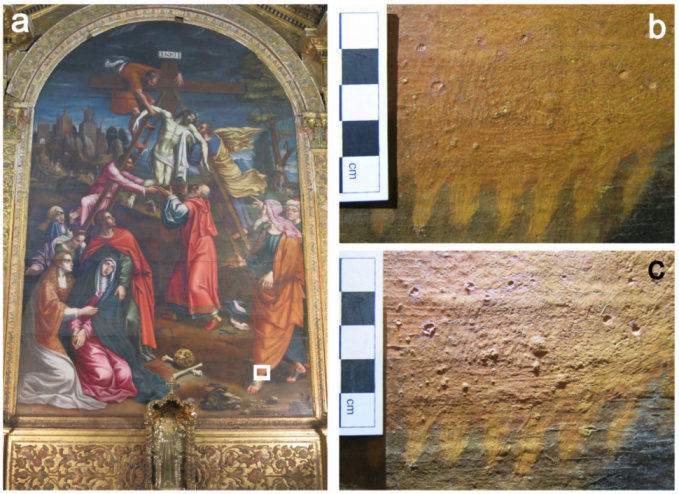
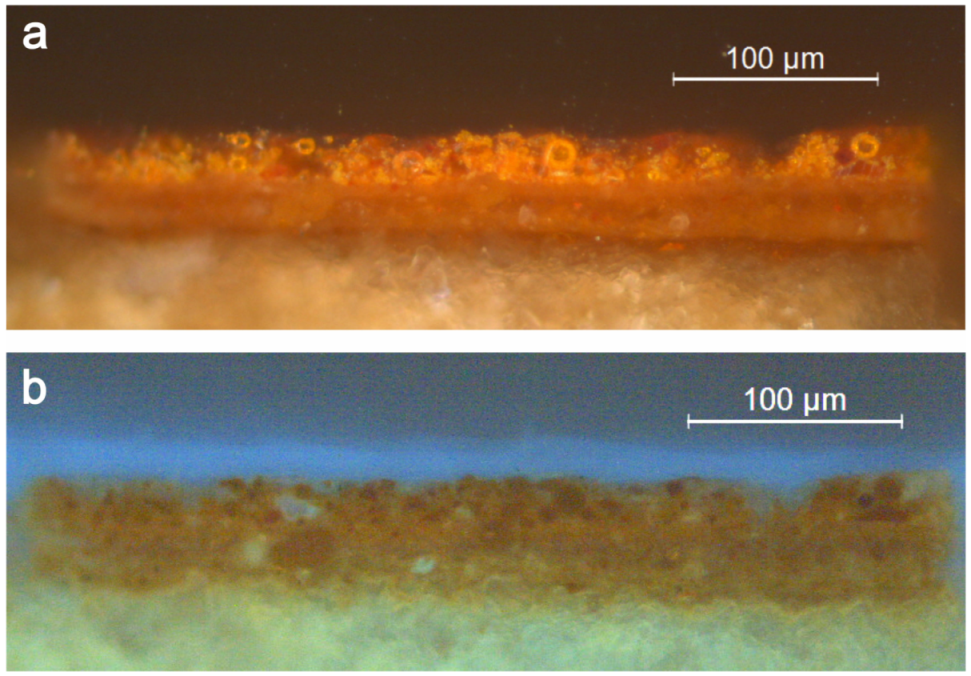




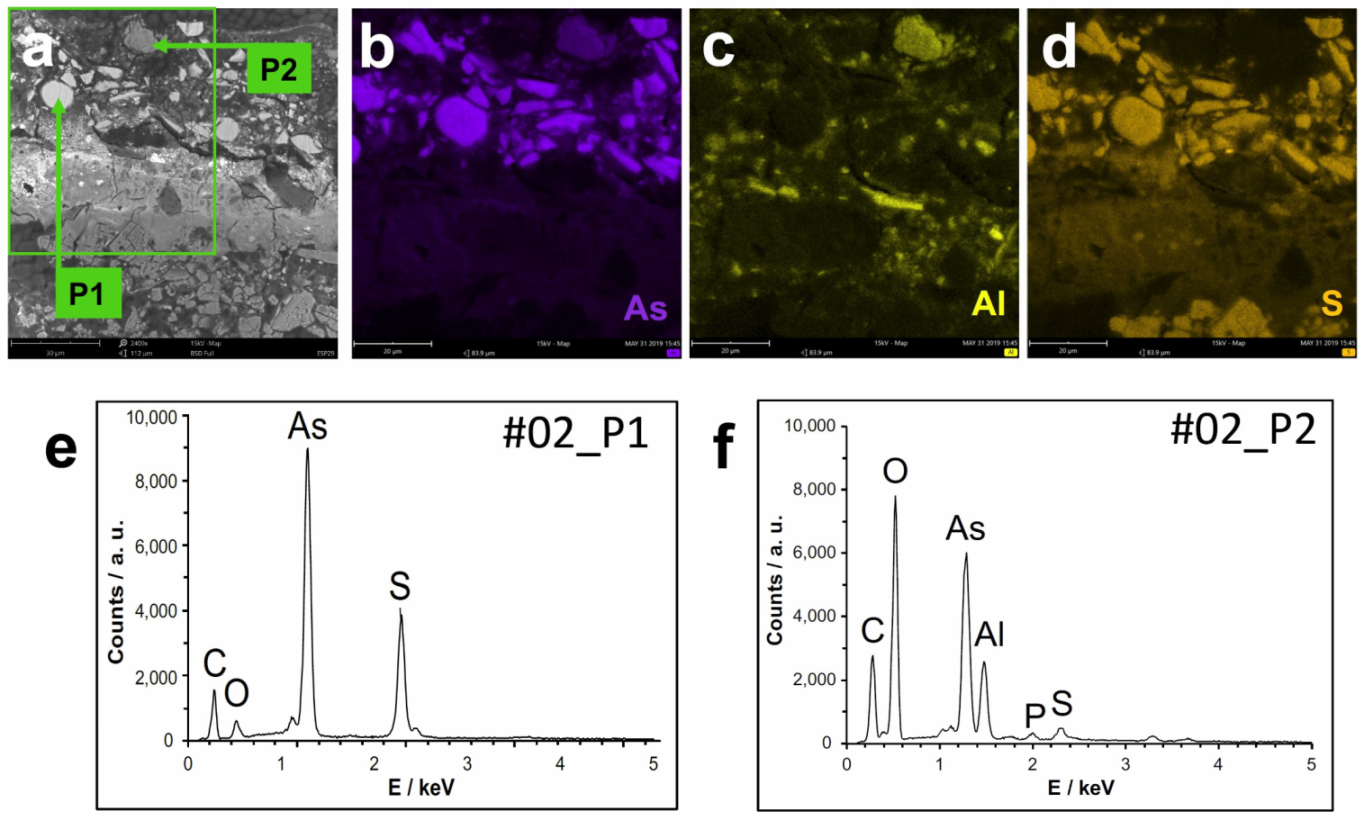
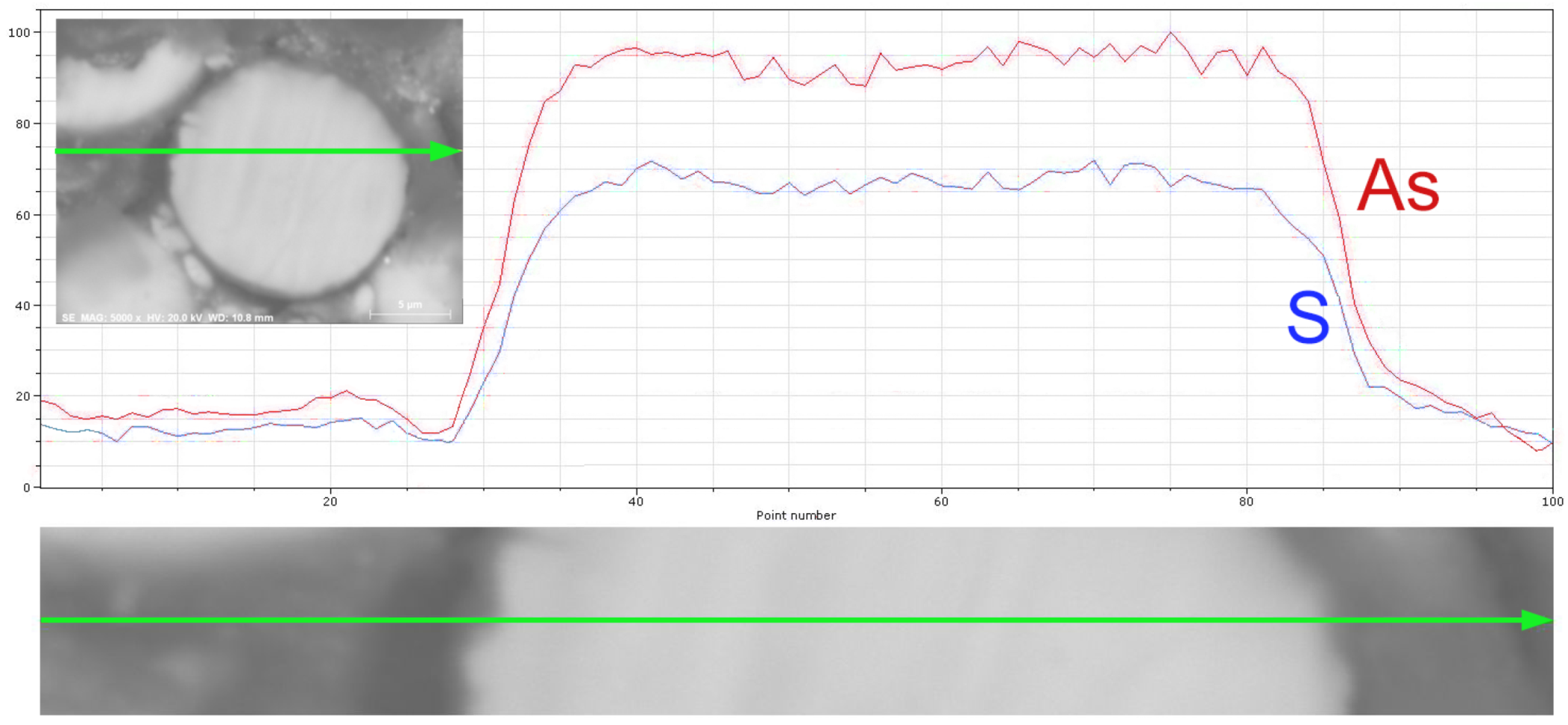

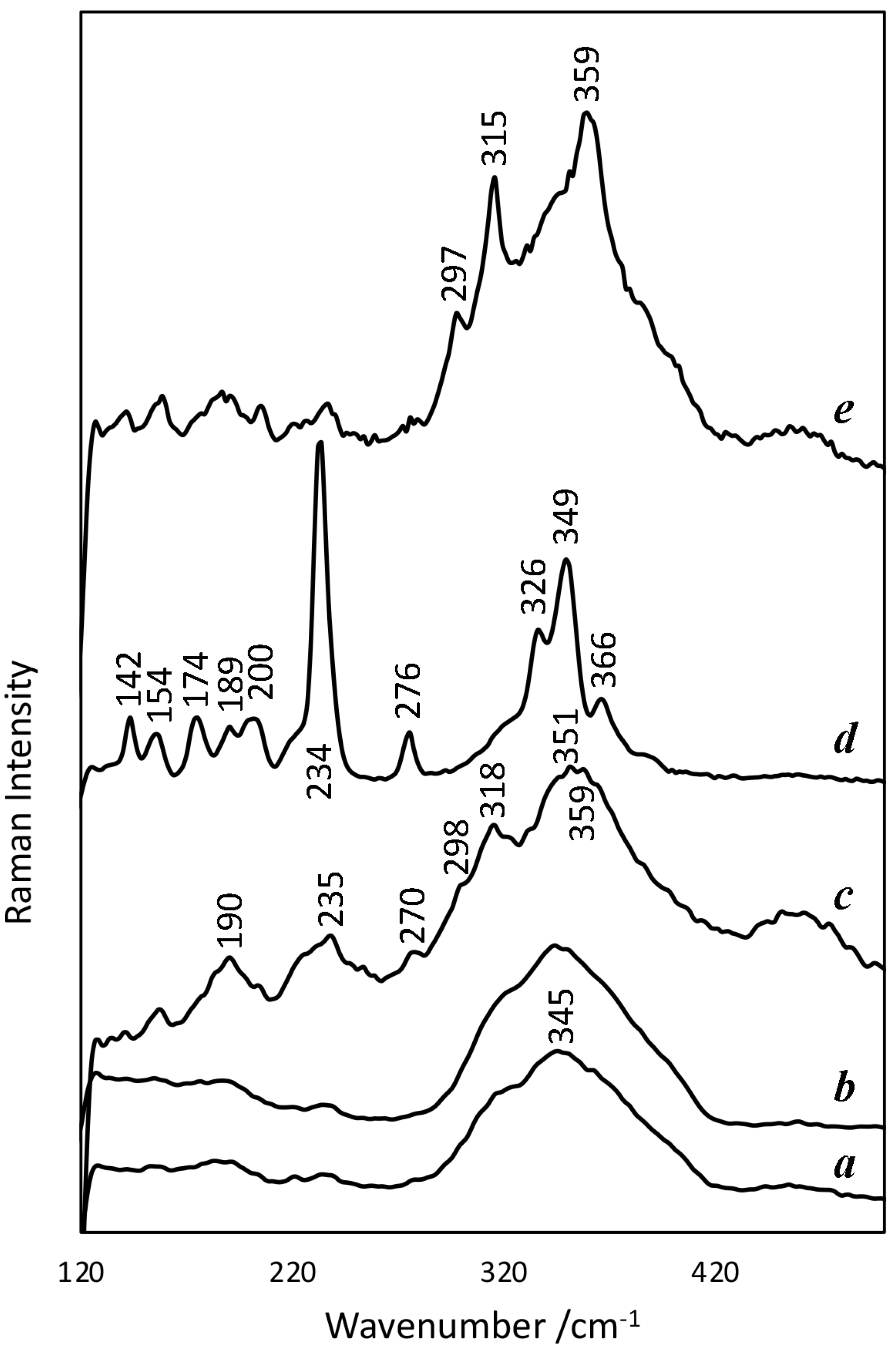
Publisher’s Note: MDPI stays neutral with regard to jurisdictional claims in published maps and institutional affiliations. |
© 2022 by the authors. Licensee MDPI, Basel, Switzerland. This article is an open access article distributed under the terms and conditions of the Creative Commons Attribution (CC BY) license (https://creativecommons.org/licenses/by/4.0/).
Share and Cite
Cruz, A.J.; Melo, H.P.; Valadas, S.; Miguel, C.; Candeias, A. The Matter from Which an Orange Colour Is Made: On the Arsenic Pigment Used in a Portuguese Mannerist Painting. Heritage 2022, 5, 2646-2660. https://doi.org/10.3390/heritage5030138
Cruz AJ, Melo HP, Valadas S, Miguel C, Candeias A. The Matter from Which an Orange Colour Is Made: On the Arsenic Pigment Used in a Portuguese Mannerist Painting. Heritage. 2022; 5(3):2646-2660. https://doi.org/10.3390/heritage5030138
Chicago/Turabian StyleCruz, António João, Helena P. Melo, Sara Valadas, Catarina Miguel, and António Candeias. 2022. "The Matter from Which an Orange Colour Is Made: On the Arsenic Pigment Used in a Portuguese Mannerist Painting" Heritage 5, no. 3: 2646-2660. https://doi.org/10.3390/heritage5030138
APA StyleCruz, A. J., Melo, H. P., Valadas, S., Miguel, C., & Candeias, A. (2022). The Matter from Which an Orange Colour Is Made: On the Arsenic Pigment Used in a Portuguese Mannerist Painting. Heritage, 5(3), 2646-2660. https://doi.org/10.3390/heritage5030138








